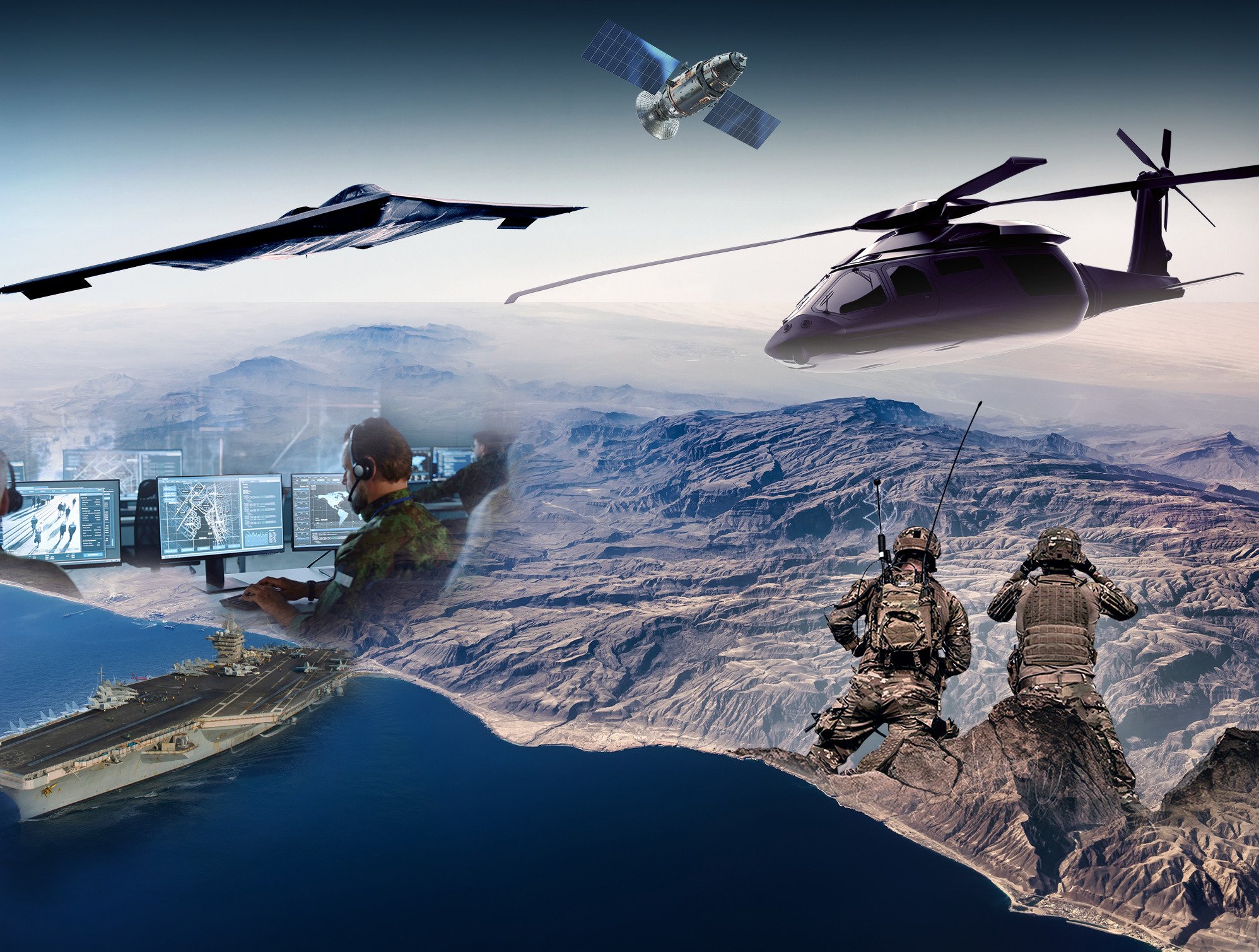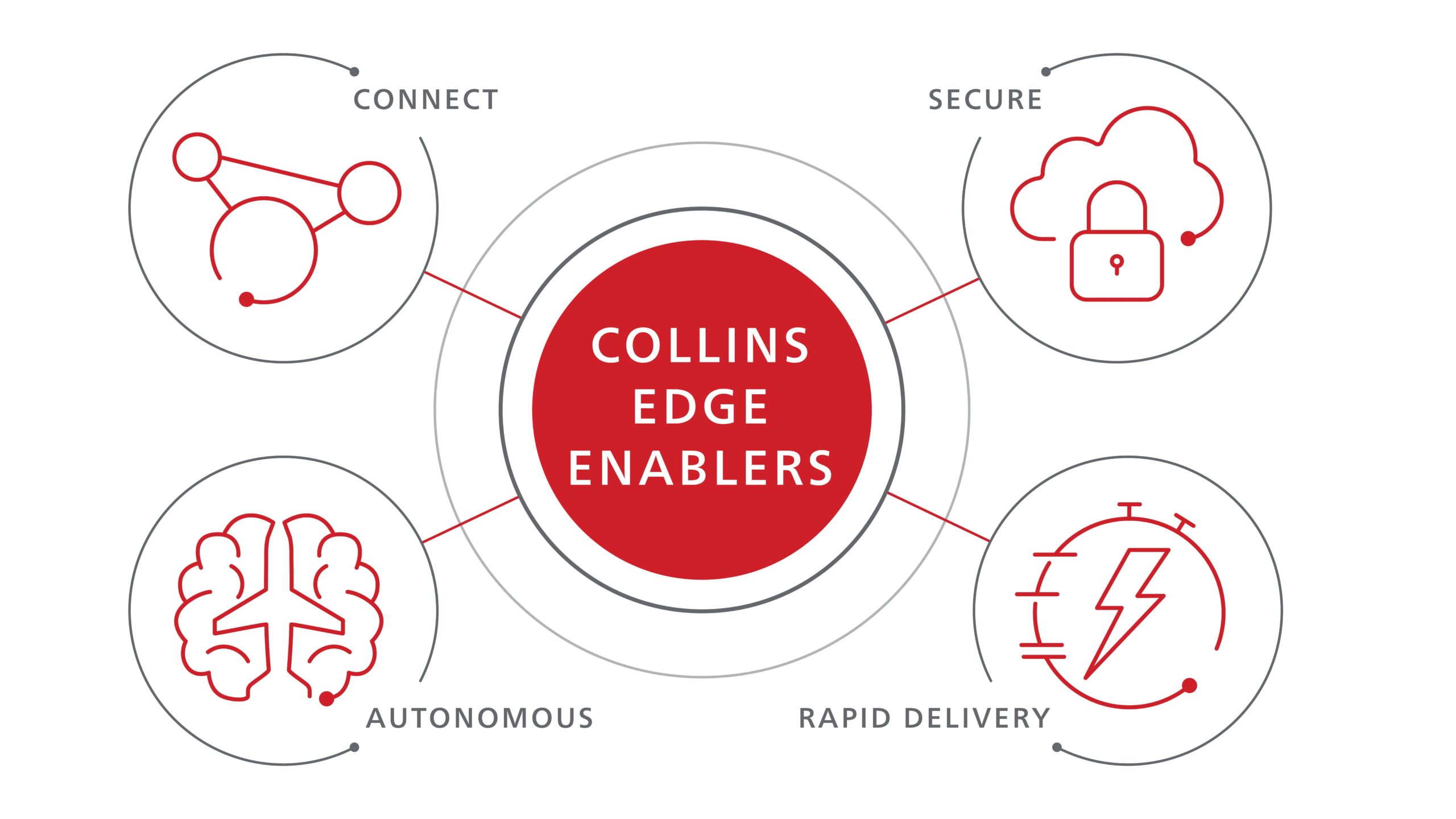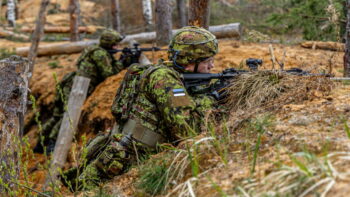
Collins Aerospace illustrates its vision for the connected battlespace.
In this Q&A with Lanny Merkel, director, JADC2 Capabilities and Proprietary Programs, Collins Aerospace, we discuss how mesh networks and existing networks/nodes can be combined into a new JADC2 backbone, how the cloud can move data across security and warfighting domains for joint operations, and the company’s support of DARPA’s effort for programs that demonstrate how 5G can be adapted to military environments.
Breaking Defense: Connecting every sensor requires a global mesh network as the backbone of joint force operations. Is it possible to create such a mesh network by connecting pre-existing networks/nodes among the military services, or are we talking about something new? Please explain.
Merkel: Establishing the global backbone is key to realizing the JADC2 vision of connecting all sensors in a real-time environment for decision makers. Changing out all the networks and radios on the existing platforms is not realistic for several reasons. In my view, the only way to achieve the backbone in a timely and cost-effective manner is through an approach that leverages existing tactical networks, augments them with commercial capabilities, and addresses the unique challenges of highly contested environments (HCEs).
First, the install base of existing networks is huge with most platforms having at least one network connection. However, most of the existing networks were developed to solve a singular problem. As a result, the networks do not talk to each other; they operate at different security levels, and have different data formats, so information becomes trapped on a network and cannot be shared. Creating gateways that connect the networks together across security domains while translating the data enables the joint services to speak the same language. The gateway approach is a cost-effective method because it does not require modification of thousands of platforms, but rather updating some key nodes.
Next, commercial 5G technologies present an opportunity to leverage the investment made by commercial telecommunications to improve military networks. Some of the advancements like the proliferated Low Earth Orbit (pLEO) constellations can provide another high-bandwidth path for communications. The individual components that are developed for 5G systems, such as directional antennas, can also be adapted for use in specific military applications. There are multiple demonstrations of the benefits of 5G that are occurring now.
Lastly, as threats have become more sophisticated, operating in HCEs require new networking capabilities. HCEs require networks that can operate covertly without being detected and while still moving the massive amount of data. The networks need to be designed so data can flow between these environments seamlessly.
Having an overall network architecture that supports the integration of both existing networks and emerging capabilities that can be adapted over time will be the key in achieving the global mesh backbone.

Collins Aerospace’s edge enablers will realize the vision for JADC2.
Breaking Defense: Explain your connectivity and secure processing solutions that provide tactical edge cloud-based computing, allowing for data sharing, autonomous, and intelligent operations that reduce decision-making timelines to machine speeds. What are the components needed for a truly connected battlespace?
Merkel: Collins Aerospace has solutions that can move data seamlessly across security and warfighting domains for the joint services and coalition partners. The U.S. Department of Defense wants to get to more modern cloud-based approaches used in personal and professional lives today when using Amazon and Google. The cloud is built on top of billions of dollars of fixed infrastructure and delivered all the way to your phone on a massive network of 5G towers. That infrastructure simply is not available in the middle of the Pacific Ocean. At Collins, we are looking at how we can provide the cloud experience to every user.
This starts with connecting all the users. Collins has a large established set of tactical communications and advanced tactical data links that can move information safely and securely in the most highly contested environments. We are also continuing to invest in new open-architecture communication systems that enable the rapid deployment and update of connectivity capabilities.
Leveraging the 5G capabilities is also a major focus area. This is being approached from a couple different angles. First, we’re exploring direct utilization of 5G networks via either wireless or the emerging proliferated LEO constellation. In this case, we are looking at the levels of enhancements, like encryption, that are required to directly use it in theater. The second involves using the components that are being developed by 5G telecoms like advanced antenna arrays that can drive down the cost and shorten the time to field solutions.
As explained earlier, gateways will be an important way to connect these multiple networks together. One of the challenges in creating a global mesh and data fabric is the existing networks and their unique data formats and messaging. Our Intelligent Gateway product combines existing networks like Link 16 with modern IP networks and translates legacy data into modern formats like Open Mission Systems/Universal Command and Control Interface (OMS/UCI) to make data access seamless to the user. The Intelligent Gateway integrates cross domain solutions to support networks at different security levels so information that is less sensitive on the network can be downgraded in real time. This avoids data becoming trapped inside a network and provides greater situational awareness to decision makers. Cross domain solutions become critical in sharing data between joint service users and coalition partners.
Breaking Defense: Late last year, Collins Aerospace successfully demonstrated a new directional communication system designed for small platforms such as unmanned aerial systems operating in contested environments. The demonstration, part of the DARPA Pheme project, showed the ability to enable connectivity in the Combined Joint All Domain Command and Control (CJADC2) battlespace. Tell me about this demonstration.
Merkel: Collins just successfully completed the capstone demo for the program in July of this year. The DARPA Pheme program is an exciting example of what I mentioned earlier of leveraging 5G capabilities in all environments. The Pheme program utilized a low-cost 5G antenna to implement a waveform. The commercial waveforms that exist today are highly optimized and efficient in delivering high-speed reliable data. In a contested environment, 5G transmissions are easy to detect and identify and can be easily jammed offline. 5G was just not designed to operate there.
In the Pheme program, Collins was able to demonstrate, using low-cost 5G hardware, that we could implement a waveform that operated covertly and resiliently, meaning it’s hard to detect and hard to jam off the air. This is achieved through directional communication, or pointing the communication signal at a specific spot. So, if I want to talk to you, I point directly at you and this is all done electronically with no moving parts. Directional communications are very effective but present a challenge in finding and keeping up with moving platforms. That’s why it’s only been applied to high-end applications.
The Pheme program showed that directional communications are possible even on low-SWaP platforms like UAS. The end system was integrated into a five-inch tube showing the very low SWaP requirements that can be achieved by integrating 5G. Recently we successfully demonstrated a multi-node air and ground network for DARPA. We will be releasing more details on that soon.

Collins Aerospace is connecting all domains through intelligent gateways.
Breaking Defense: Also last year, Collins Aerospace successfully demonstrated advanced communication, mission computing, and sensor technologies to support CJADC2 (Combined Joint All Domain Command and Control) and ABMS (Advanced Battle Management) initiatives for Valiant Shield-22. How does it fit into the larger mesh network we discussed earlier?
Lanny Merkel: Valiant Shield 2022 allowed us to demonstrate the capabilities that we have been discussing as a proof of concept and how they can be integrated and delivered today. At the exercise, Collins Aerospace had the intelligent gateway installed on the KC-135 platform as part of a cooperative agreement with the Air National Guard. During the exercise we were able to show two major operational benefits provided by enhanced connectivity.
The first was closing a long-range kill chain from multi-INT sensing in exercise near Guam all the way back to the Common Mission Control Center (CMCC) at Beale AFB, a distance of nearly 6,000 miles. The sensor data was pushed to the KC-135 through a data link, and from there the intelligent gateway routed the information automatically over Military Beyond Line Of Sight links to get back to the CMCC.
In the second, the Common Operating Picture (COP) was pushed from Beal to the KC-135 then distributed through multiple networks to new ground, air, and joint service users. The additional situational awareness provided by the COP helped all users make better and more informed decisions quickly. The exercise showed that this connectivity can enable new concepts like Agile Combat Employment (ACE) by providing the connectivity and data even to disadvantaged users.
For Northern Edge 23, additional capabilities are being planned for the demonstrations. A couple of key areas are the addition of commercial LEO satcom and the directional communications capability. The event is still in the planning phase so more to come as plans become finalized.
Breaking Defense: What is the role of open systems in connectivity and how is Collins helping to promulgate the use of open systems?
Lanny Merkel: Open architecture solutions are the future of connectivity solutions. Collins is currently executing on multiple open architecture programs across all the services. Today there are still multiple competing standards that cover connectivity. Collins is leveraging investments from across the services to develop and advance technology that supports the open system needs for the joint force.
Over the past year Collins has conducted lab and airborne demonstrations of these solutions. We also plan to demonstrate our open architecture communication system at one of the JADC2 exercises later this year.





















